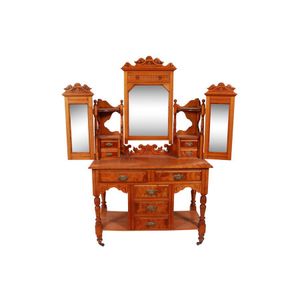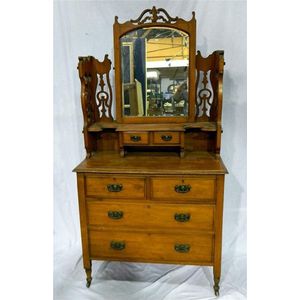A Victorian dressing table, usually in the Rococo revival style. It generally has heavy cabriole or scroll legs standing on a platform base, although turned and reeded legs are not uncommon. The table. top may be rectangular or serpentine in shape. The superstructure consists of an oval or rounded mirror supported by carved brackets, beneath which are two or three small drawers for gloves, pins, jewellery and so on. Normally made from walnut, mahogany or cedar. A duchess chest is a term frequently, though some-what misleadingly, applied in the Australian antique market to a combination chest. It consists of
more...
a chest of drawers surmounted by a swing mirror flanked by several small drawers for gloves or studs. Mainly found in Edwardian furniture, both in pine and cedar.
less...
A table or cabinet fitted with mirrors, small drawers and compartments, used especially by ladies at their toilette. There have been many variations over the past two centuries. The great 18th century designers delighted in contriving elegant tables, ingeniously fitted with all kinds of sliding and hidden mirrors, drawers and cosmetic boxes. Some versions had small bookshelves and drawers in the superstructure, while others were plainer, square tables, with fold over lids which, when opened, revealed the mirrors and compartments.
Victorian dressing tables followed the prevailing fashions of the various revival styles, although the form became established as a table
more...
supported by scroll, turned or cabriole legs, with an oval or square mirror and a series of small drawers known as a Duchess dressing table. Another version consisted of two pedestals, fitted with drawers on either side of a cheval mirror.
Edwardian dressing tables were usually plainer, with typical turned legs, squarer lines and sometimes containing wing mirrors. These Edwardian pieces usually contain sections of machine-made carving, based on the acanthus leaf, sometimes in conjunction with various Neoclassical devices such as the broken pediment, shallow reeding and so on.
The revival of the Queen Anne style in the 20th century saw many dressing tables in ash or maple made with cabriole legs and plate glass mirrors. They are usually stained a revolting scarlet described by the manufacturers as 'mahogany'.
less...
Until the mid-19th century, the standard chest had either four long, or three long and two short drawers. Rarely were there any exceptions to this rule. A chest with three drawers, or a series of small upper drawers, purporting to be Georgian, will probably have been converted from a chest-on-chest or tallboy. It is true that the 18th century commode often contain two long deep drawers, but this was a much grander and more decorative piece altogether, intended for drawing rooms, not bedrooms, and in any case was usually made to stand on legs. The standard chest
more...
of drawers continued to be made throughout the 19th and early 20th centuries (some Edwardian pine chests even had bracket feet), but variations were introduced during the mid-Victorian period, with some chests having seven or more drawers usually a deep hat drawer and smaller glove compartments. Chests with barley-sugar twist or split bobbin-turned supports date from the mid-19th century.
less...







 Loading more...
Loading more...